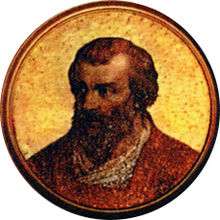Pope Celestine III
| Pope Celestine III | |
|---|---|
 | |
| Papacy began | 30 March 1191 |
| Papacy ended | 8 January 1198 |
| Predecessor | Clement III |
| Successor | Innocent III |
| Orders | |
| Ordination | 13 April 1191 |
| Consecration |
14 April 1191 by Cardinal Ottaviano |
| Created Cardinal |
February 1144 by Pope Celestine II |
| Personal details | |
| Birth name | Giacinto Bobone |
| Born |
c. 1106 Rome, Papal States, Holy Roman Empire |
| Died |
8 January 1198 Rome, Papal States, Holy Roman Empire |
| Previous post | Cardinal-Deacon of Santa Maria in Cosmedin (1144-1191) |
| Motto | Perfice gressus meos in semitis tuis ("Going in Thy path") |
| Signature |
|
| Other popes named Celestine | |
| Papal styles of Pope Celestine III | |
|---|---|
 | |
| Reference style | His Holiness |
| Spoken style | Sanct(issim)e Pater |
| Religious style | Holy Father |
| Posthumous style | None |
Pope Celestine III (Latin: Caelestinus III; c. 1106 – 8 January 1198), born Giacinto Bobone,[1] reigned from 30 March or 10 April 1191[2] to his death in 1198. He was born into the noble Orsini family in Rome and served as a Cardinal-Deacon prior to becoming pope.[3] He was ordained as a priest on 13 April 1191 and he ruled the church for six years, nine months, and nine days before he died aged 92. He was buried at the Lateran.
Biography
Cardinal
Considered by the Roman Curia as an expert on Spain, Bobone conducted two legatine missions to Spain in (1154–55) and (1172–75) as the Cardinal-Deacon of Santa Maria in Cosmedin.[4]
Pontificate
He crowned the Holy Roman Emperor Henry VI on the day after his election in 1191 with a ceremony symbolizing his absolute supremacy, as described by Roger of Hoveden. Later in the same year he threatened to excommunicate King Tancred of Sicily, forcing him to release his aunt Empress Constance, who was wife of Henry VI and a contender of Sicilian crown, captured by Tancred earlier the same year, to Rome to exchange for his recognition of Tancred while also put pressure on Henry, but Constance was released by German soldiers on borders of the Papal States before reaching Rome the following summer. He subsequently excommunicated the same Henry VI for wrongfully keeping King Richard I of England in prison.[5] He placed Pisa under an interdict, which was lifted by his successor Innocent III in 1198.[6] He condemned King Alfonso IX of León for his marriage to Theresa of Portugal on the grounds of consanguinity. Then, in 1196, he excommunicated him for making peace with the Muslims while making war on Castile. Following his marriage with Berengaria of Castile, Celestine excommunicated Alfonso and placed an interdict over León.[7]
In 1198, he confirmed the statutes of the Teutonic Knights as a military order.[8]
Death

He would have resigned the papacy and recommended a successor (Cardinal Giovanni di San Paolo, O.S.B.) shortly before his death,[9] but was not allowed to do so by the cardinals.[10]
Notes
- ↑ The New Cambridge Medieval History, Vol.1, Ed. David Luscombe, Jonathan Riley-Smith, (Cambridge University Press, 2004), 417.
- ↑ http://www2.fiu.edu/~mirandas/bios1144.htm#Bobone
- ↑ The New Cambridge Medieval History, Vol.1, 417
- ↑ The New Cambridge Medieval History, Vol.1, 417–418.
- ↑ Sikes, Thomas Burr, History of the Christian Church, from the first to the fifteenth century, (Eliott Stock, 1885), 187.
- ↑ Clarke, Peter D., The interdict in the thirteenth century: a question of collective guilt, (Oxford University Press, 2007), 118.
- ↑ Moore, John Clare, Pope Innocent III (1160/61–1216): to root up and to plant, (Brill Publishers, 2003), 70–71.
- ↑ Urban, William, The Teutonic Knights, (Greenhill Books, 2003), 12–13.
- ↑ William Stubbs (editor), Chronica Magistri Rogeri de Houedene Vol. IV (London 1871), pp. 32-33.
- ↑ Karl Holder, Die Designation deer Nachfolder durch die Päpste (Freiburg Switzerland: B. Veith 1892), pp. 69-70.
References
- Clarke, Peter D., The interdict in the thirteenth century: a question of collective guilt, Oxford University Press, 2007.
- Gregorovius, Ferdinand, History of the City of Rome in the Middle Ages Volume IV, part 2 (translated from the 4th German edition by A. Hamilton) (London: George Bell 1896), pp. 625-638.
- Moore, John Clare, Pope Innocent III (1160/61–1216): to root up and to plant, BRILL, 2003.
- Mann, Horace K., The Lives of the Popes in the Middle Ages Volume X (London: Kegan Paul 1914), pp. 383-441.
- Sikes, Thomas Burr, History of the Christian Church, from the first to the fifteenth century, Eliott Stock, 1885.
- The New Cambridge Medieval History, Vol.1, Ed. David Luscombe, Jonathan Riley-Smith, Cambridge University Press, 2004.
- Urban, William, The Teutonic Knights, Greenhill Books, 2003.
- Pope Celestine III (1191-1198): Diplomat and Pastor, ed. Damian J. Smith, John Doran, Ashgate Publishing, 2008.
External links
| Wikisource has the text of the 1911 Encyclopædia Britannica article Celestine (popes). |
| Catholic Church titles | ||
|---|---|---|
| Preceded by Clement III |
Pope 1191–98 |
Succeeded by Innocent III |
initial text from the 9th edition (1876) of an old encyclopedia

